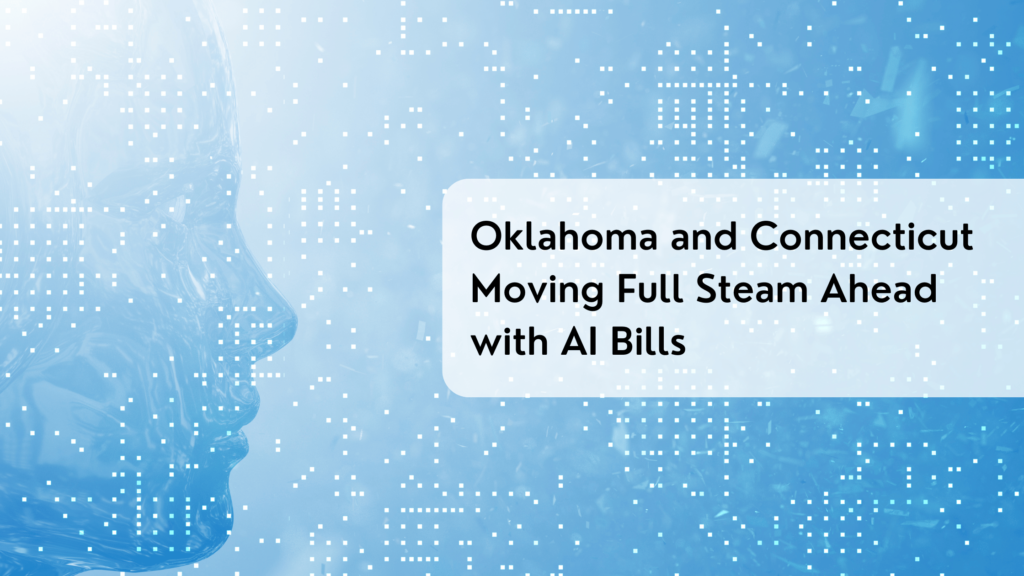
Oklahoma and Connecticut Moving Full Steam Ahead with AI Bills
As states across the U.S. move to regulate artificial intelligence (AI) systems, Oklahoma and Connecticut have recently introduced bills aimed at governing AI usage within their jurisdictions. While both bills share common objectives of promoting transparency and protecting citizens’ rights, they differ in certain provisions and approaches.
We’re tracking a total of 15 pending state laws, now that Utah has passed. These two are moving through legislation rapidly and illustrate some of the contrasts in AI legislation. Utah took an approach around large language models and true AI, closing the consumer gap by focusing on notice and transparency. California’s approach to ADMT is extremely broad and reaches into any type of machine learning.
With Connecticut and Oklahoma, we’ve got two politically different states that are both deeply concerned about AI. Looking at Oklahoma’s bill, it’s closer to Utah and extends definition beyond large language models to anything that learns. There’s a high degree of focus on consumer rights, imitating privacy legislation, with added depth to transparency and notice. It aligns with the privacy bill of rights concept, mirroring the White House Order on AI.
Connecticut started with a heavy emphasis on bias and has evolved into a much more comprehensive bill, governing AI on a grander scale. The Connecticut bill is more aligned with California’s in that anything that constitutes machine learning is in scope. We think you’ll see close ties between privacy and AI statutes with more movement towards the Connecticut-style expansion of bills to be more inclusive of all machine learning.
Let’s explore the key points of comparison between the proposed AI bills in Oklahoma and Connecticut:
Oklahoma HB 3453
- Introduced by Boatman, Pae, Maynard, and Gollihare, the bill offers comprehensive definitions of AI and establishes rights for Oklahomans interacting with AI systems.
- Defines “artificial intelligence” broadly to include systems that perform tasks autonomously and can learn from experience.
- Guarantees citizens’ rights to know when interacting with AI engines, ensuring transparency and informed decision-making.
- Protects citizens’ authenticity by granting the right to verify the authenticity of AI-generated content through watermarks or content credentials.
- Upholds individuals’ privacy rights by requiring companies to implement reasonable security measures for data privacy within their industries.
Connecticut SB 2
- Establishes requirements concerning the development, deployment, and use of certain artificial intelligence system
- Establishes an Artificial Intelligence Advisory Council.
- Requires state agencies to study potential uses of generative artificial intelligence and propose pilot projects.
- Expected to align with the broader trend of state-level AI regulation aimed at promoting responsible AI development and usage.
- Heavy emphasis on workforce AI training programs.
- Requires public disclosures, so citizens are made aware when they are interacting with an AI system.
Key Takeaways:
- Both Oklahoma and Connecticut are addressing the need for AI governance to ensure ethical and transparent AI practices.
- While Oklahoma’s bill offers specific definitions and rights for citizens interacting with AI, Connecticut’s bill is expected to follow suit with similar objectives.
- Organizations operating in Oklahoma and Connecticut will need to monitor and adapt to the evolving regulatory landscape to ensure compliance with AI regulations.
As always, we will likely see amendments to these bills as they progress through the legislative process. We continue to see the same common elements: transparency, training, and consumer rights. Click here for more information on how Truyo can help your organization navigate AI governance and compliance with these and other upcoming AI regulations.
